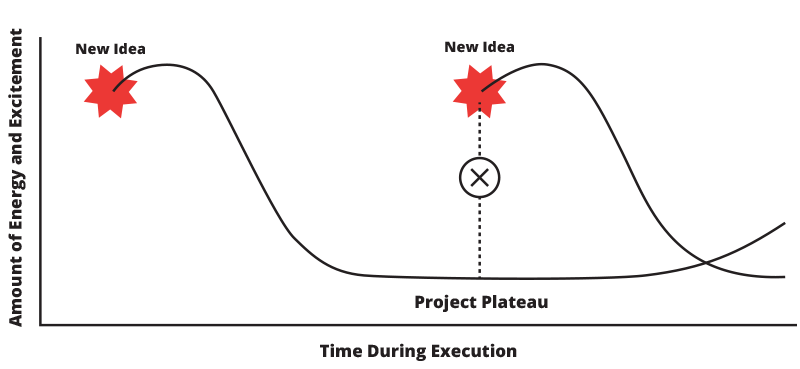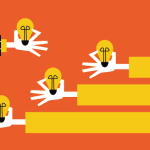The Project Plateau: The Quicksand of Innovation
Ideas are exciting. Thinking up new ideas and working on them gives a lot of energy. However the further you develop your idea, the harder it gets to stay committed. There comes a moment when your excitement will turn into frustration, simply because you are primarily engaged in checking things off your to-do list. This is the phase where most ideas (even great ones) are abandoned by their creator.
In his must-read book “Making Ideas Happen” Scott Belsky describes this stage as the “Project Plateau”. A well known moment in time when the execution of an idea swallows so much of your time that you lose all your enthusiasm and are looking for a way out. Since there is almost always another idea lurking in the background, it’s easy to leave and work on that other exciting project. Although this will again result in a high energy and commitment zone it will also cause us to lose focus. The result: a plateau filled with skeletons of abandoned ideas and little or no executed ideas.
The Project Plateau © Scott Belsky
It is in our nature to continuously come up with new ideas and to work on several projects at the same time. It goes without saying that this is time consuming and unproductive. It makes it very hard to finish projects and to realise innovation.
The truth is: if you want to be a true innovator you will have to bite the bullet. Execution and implementation are hard work and demand a lot of discipline.
There are a few things you can do to stay committed to a project.
1 ) Get Started
If you have an idea, go do it. Waiting is deadly for all creative ideas. If your idea is truly remarkable you have to execute it right away. Don’t make excuses. The longer you wait, the harder it will get.
To quote Mark Twain: “The secret of getting ahead is getting started. The secret of getting started is breaking your complex overwhelming tasks into small manageable tasks, and starting on the first one.”
2 ) Make Progress Visible
Work in sprints and make sure that you always end up with a result. (A prototype, business model canvas, visualisation, presentation, pitch, user interface, customer journey etc.) It should be clear to anyone -your team, supervisors and yourself- what has been achieved so far. Let everybody see & celebrate the small victories. Make sure that all steps that have been taken are visible somewhere. (Use a Scrum Board or keep a history wall with all your finished checklists. )
3 ) Kill Your Darlings
If you want to be productive, feedback is important. Always stay honest with yourself when it comes to the future of your ideas. New ideas are always fun, yet once you realise that your project has no future you should kill it without hesitation. An idea that has no added value to you or your customer does not deserve your time and energy.
Killing the project will supply you with time and will help you to focus on the important stuff.
Like this article?
If you enjoyed reading this article, feel free to share it with your network by hitting one of the buttons below. This way other people can benefit from the article as well.






